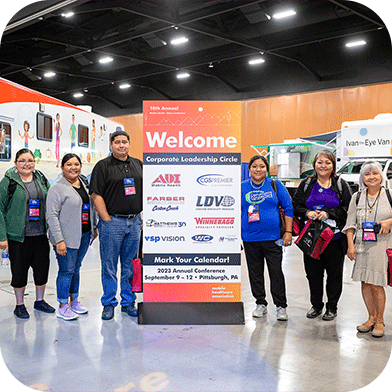Special Interest Mobile Healthcare: Tribal Health

Tribal Health mobile healthcare delivers care to tribal and First Nations populations with significant barriers to accessing medical, behavioral health and oral health resources. These mobile clinics must be executed with great awareness and inclusion, given the population’s experiences of social inequality, historical trauma, and discrimination.
Goals
- Provide care to Native American and First Nations populations who face significant access to care, including geographic barriers, poverty, lack of trust, etc.
- Improve health literacy for individuals with significant barriers.
- Help establish medical homes.
Considerations
Gaining trust: It’s essential to understand and account for the historical and social reasons for a lack of trust in institutions. Here are a few ways programs have broken through this barrier:
Involve tribal leadership in program creation, so that there is a clear mandate/endorsement/sanction for the care that will be delivered.
Partner with groups within the tribe.
Do outreach before showing up, letting the elders and other members of the community know you’re coming.
Ask tribal elders to bless the vehicle, at least at the onset of the program and possibly on every visit.
Type of treatment: Depends upon the needs of the tribal population. It can range from prenatal, natal and infant care to mammography to chronic diseases like asthma and diabetes, to oral health, to a medical surgical unit that has performed more than 10,000 surgeries (a program in New Zealand). In especially remote areas, you might want to offer more general services.
Referrals: While avoiding being patronizing, it may be necessary to provide information and a path to get people to all types of doctors and other healthcare providers. That could mean asking if an individual wants you to make the appointment or putting in a note to ask again at the next visit.
Rural locations: Many members of tribal communities live in very remote areas. There may not be electricity or running water. It can require hours of driving to get from one stop to another. To ensure that people will show up for the clinics, this means you must do marketing in advance—through radio, social media, flyers, etc.
Locations: Look to chapter houses, flea markets, gas stations, schools and other natural gathering areas.
Contact information: Update contact information at each visit, especially in rural areas, so that you can reach out directly when returning to the area.
Connectivity: Do not assume you will have WiFi or cellular connection, especially in more rural areas. (One program received a grant to set up DSL at chapter houses in various locations.)
Medications: You may want to have medication on board or build a relationship between an institution with a pharmacy (like a hospital) and members of the community.
Refrigeration/Freezers: Necessary for keeping vaccines, lab work and other tests safe.
Staffing: Staffing varies based on services, but can include a doctor, a nurse practitioner, a midwife, a medical assistant and, of course, a driver, who should play multiple roles.
Resources
- Mobile Health Map
- The scope and impact of mobile health clinics in the United States: a literature review
- NIHB Tribal Health Reform Resource Center
- Rural Health Information Hub
- Health coverage for American Indians & Alaska Natives
Next Steps
- Become a member of Mobile Healthcare Association
- Review our start-up resources, some for members only.